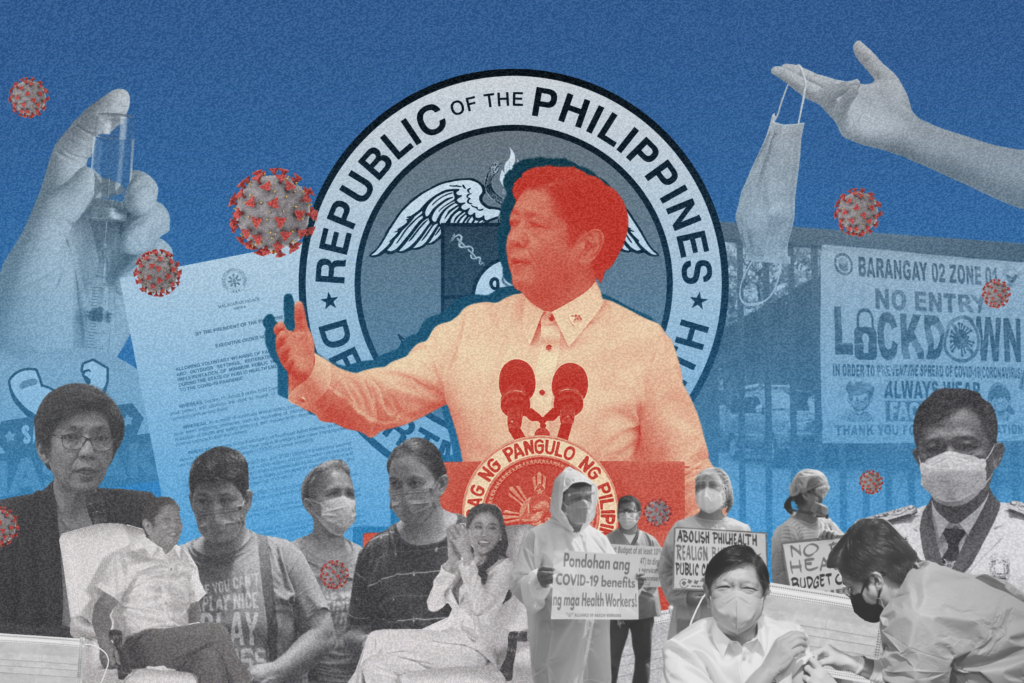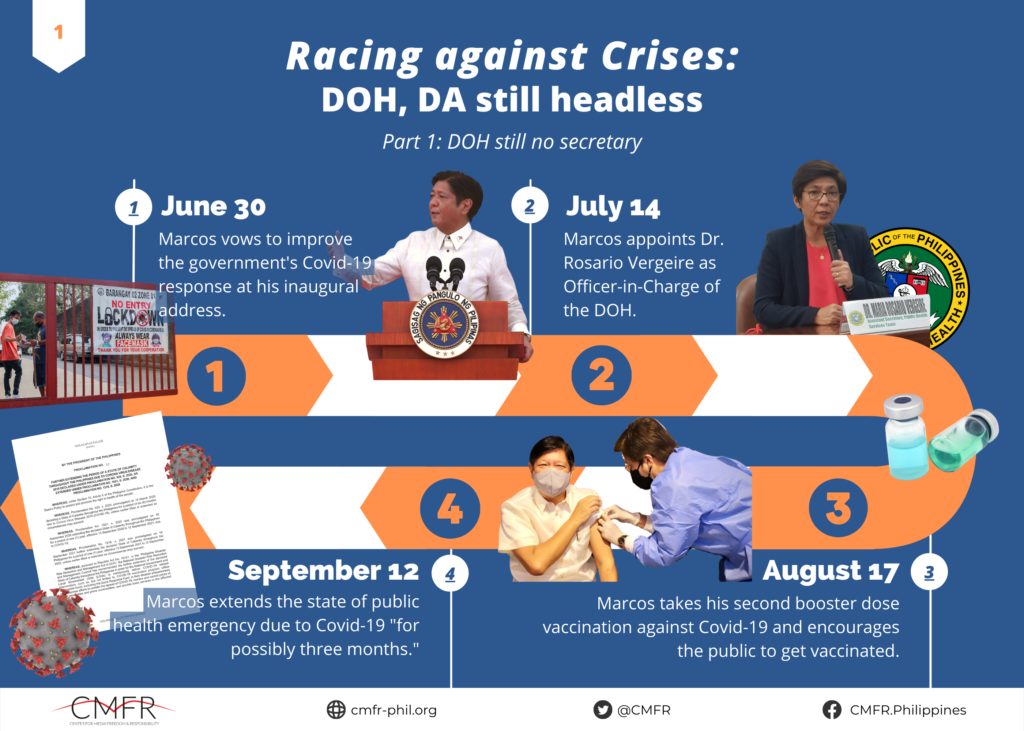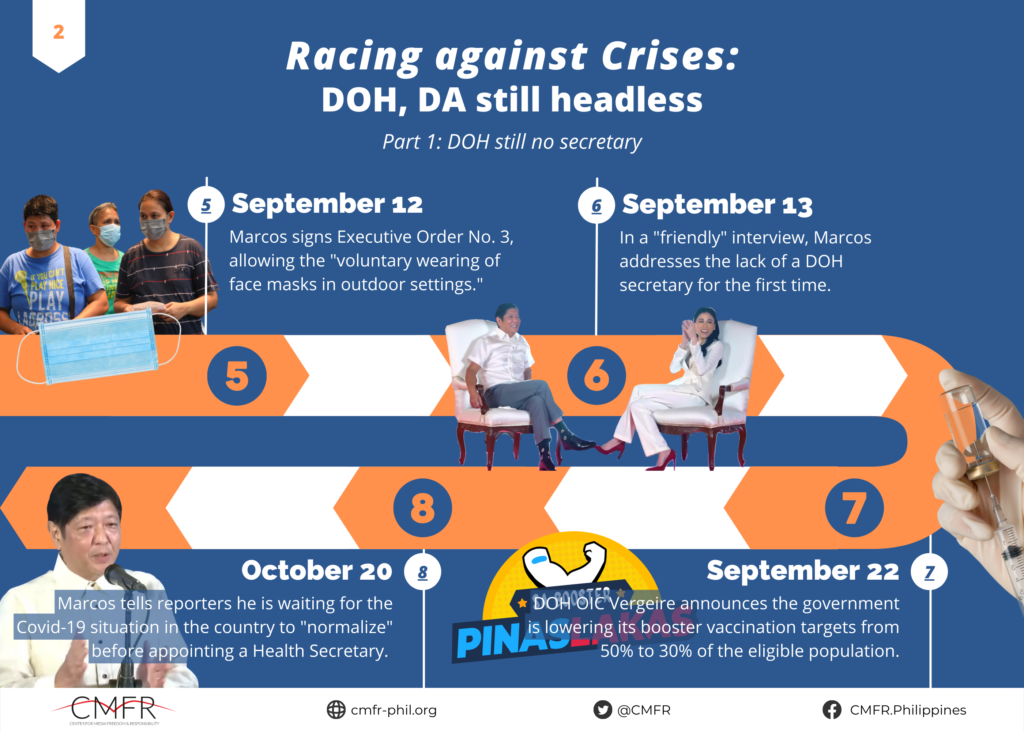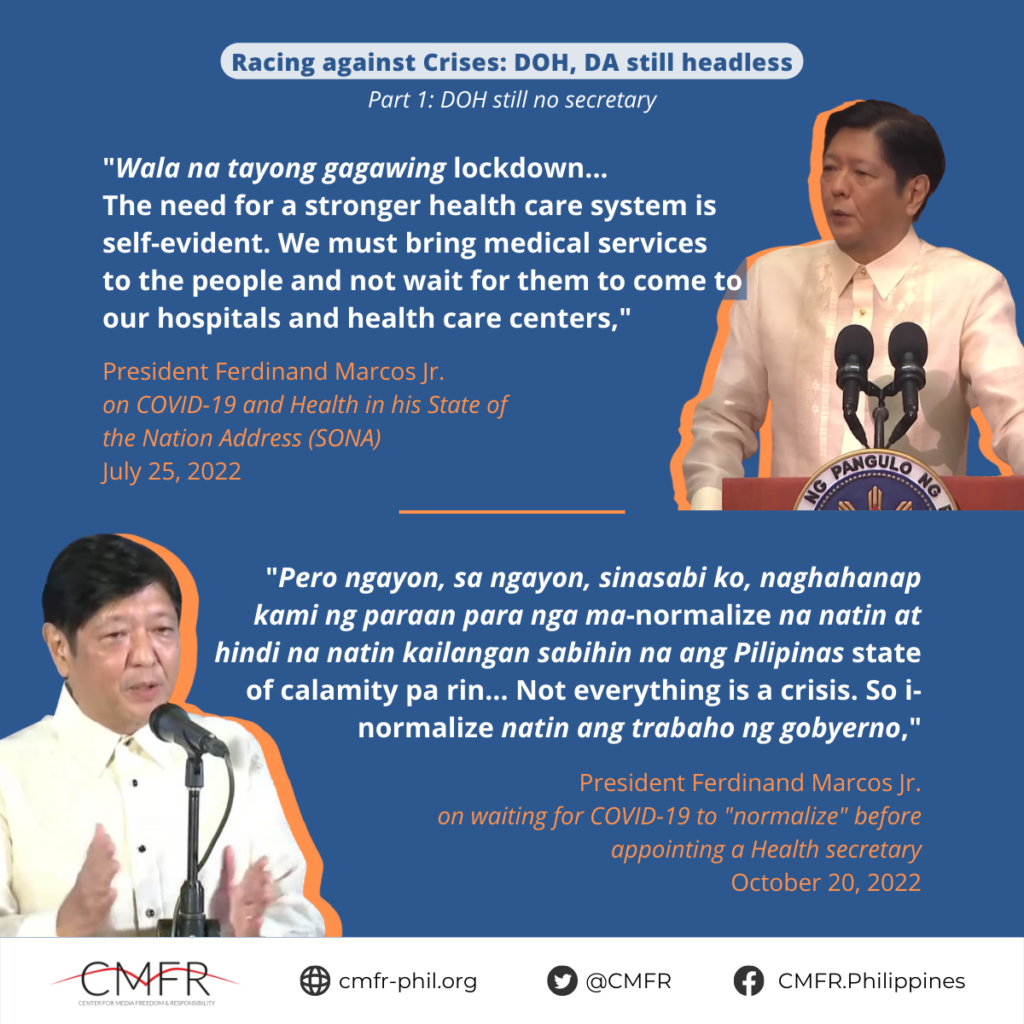Racing against Crises: DOH, DA still headless
First of two parts: DOH still has no secretary

SEVERAL MONTHS into the job, President Ferdinand “Bongbong” Marcos Jr. has yet to appoint qualified persons to oversee the departments charged with food production and health – two basic concerns affecting the people’s welfare. With both sectors already in bad shape before he assumed office, the appointments to both departments were of greater urgency if the government were to avert further crises.
CMFR reviewed news reports from June 30 to November 1, tracking information about policy and action on the part of the President – or the lack of these – in the Health and Agriculture departments. Both suffer from a lack of leadership that has led to uncoordinated policies.
Media have reported on these problems, but the coverage was mostly without the necessary context – the crucial lack of leadership in either department.
In the case of the Department of Health (DOH), policy and action to ensure the continuing protection of the population and the necessary upgrading of hospital systems have been put on hold, with the public health objectives overcome by other sectoral objectives.
Timeline of Promises vs Policies
The threat of the COVID-19 virus and its subvariants makeup only one layer of concern. For almost three years now, the longstanding inadequacies of both private and public hospitals have been heightened by pandemic pressures. Sometime this year, public authorities had called attention to the threat of other communicable diseases that include dengue, hand-foot-and-mouth disease, leptospirosis, and cholera. With no prime authority at DOH, all strategic planning is on hold.
Marcos was quick to promise a “systematic” health response. But he has so far not delivered. The entry of monkeypox cases into the country last July was quickly followed by new variants of COVID-19. With the continuing rise of health issues that need to be addressed, the President has allowed the DOH to remain headless for more than four months after he took office.
The timeline below establishes how the President has managed, or has failed to, address health issues especially the COVID-19 pandemic:


Marcos’ failure to appoint Health Chief
The health secretary post has always been a key appointment in any administration, given how intertwined public health is with public welfare. The first graph shows that the President seems aware that COVID-19 and its variants demand prompt attention and action. And yet all he did was to name an Officer-in-Charge (OIC), a position that lacks the full authority to undertake the job. While publicizing his getting a booster shot to bolster the campaign, there has been no strong and widespread government communication strategy to call on the public to do the same.
The second graph reveals Marcos’ lack of understanding of the problem. Guided by the different government officials pushing for economic recovery, the President signed Executive Order (EO) No. 3 that makes mask-wearing outdoors voluntary – a measure opposed by OIC Maria Rosario Vergeire who had been saying that wearing masks was DOH’s default position. Health reform advocate Tony Leachon noted that the optional masking rule is “counterintuitive” and the messaging of the government on the matter is “very confusing.” He also pointed out the added confusion of the DOH’s infographics released days before EO No. 3 was signed, which reminded the public of the need for protection against COVID-19 by wearing masks outdoors. Further, Marcos signed EO No. 7 on October 28 allowing the voluntary wearing of masks indoors.
The first time the President talked about the DOH head vacancy was in an interview with a media personality who had no credentials as a journalist. The “friendly” interview showed no analytical discussion, and the President went on to talk without making any point: “That’s why until we finalize the structure of what (DOH) — we just have to keep it functioning and finalize the structure and then actually I’m hoping and I’m thinking that the person who is helping us, the consultants from there, the consultants that are helping us, putting the new structure of the DOH together, diyan manggagaling ‘yung ating bagong secretary.”
The last policy gaffe was announced by Vergeire herself. In the same month of the signing EO No. 3, DOH announced on September 22 that it would not be able to reach its earlier inoculation target. In July, the DOH launched the “PinasLakas” immunization campaign that sought to administer COVID-19 boosters to 50 percent of the eligible population — or 23.6 million individuals — within the first 100 days of the Marcos administration. But it was lowered to only 30 percent “due to the pace at which our booster vaccination is going,” Vergeire said.
At this point, there has been no way to discuss a long-term and strategic plan for recovery and rehabilitation of the national health system and the state of hospitals. Determined to revive economic activities, the government has marginalized the public health perspective as the DOH is represented only by an Officer-in-Charge and a former Police Chief as Health Undersecretary, whose credentials do not match those of the leaderships of other departments.
The Philippine Daily Inquirer’s October 23 editorial pointed out that it “is ironic that the lead government agency in charge of managing the health crisis… would be the last to get a full-fledged secretary.” Earlier on September 26, Peter Wallace in the same newspaper urged Marcos to appoint a Secretary immediately as it is “no exaggeration that people are dying.”
In his first State of the Nation Address on July 25, Marcos promised to “fix” the COVID-19 pandemic without lockdowns and with more specialty hospitals outside of Metro Manila.
During the 48th Philippine Business Conference and Exposition 2022 on October 20, a DZMM reporter asked correctly when Marcos would appoint a Health Secretary. This question was answered at length with loops of how “we have to get away from the emergency stance of the DOH because we have to open up businesses” to how COVID-19 should be treated like “flu, pneumonia.”

The President read a prepared speech written for him, which he delivered with much promise. But there has been little action to fulfill that promise. It ends with his remarks in October as he responded to the question cited above. His answer revealed how little he really knows or understands about the challenges of the pandemic. There is little evidence that he has tried to learn more about what needs to be done to upgrade systems that will be beneficial for more Filipinos. “Normalization” requires a comprehensive, concerted effort which requires knowledgeable and authoritative leadership at the DOH. Without it, all we can expect is more confusion and worthless words as policy for health.
Also See, “Last of two parts: Absentee DA secretary“
Leave a Reply